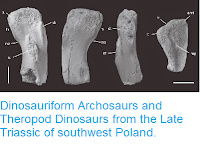Triassic and Jurassic terrestrial Vertebrate fossils have been periodically collected from the central Transantarctic Mountains of Antarctica since the 1960s. The Early Triassic Graphite Mountain assemblage is of particular interest, as it produces Early Triassic fossils that clearly belong to the Lystrosaurus Assemblage of the Karoo Basin in South Africa, as well as other fossils unique to Antarctica, giving insights into the recovery of southern high latitude faunas following the End Permian Extinction.
In a paper published in the Journal of Vertebrate Paleontology on 31 January 2019, Brandon Peecook of the Integrative Research Center at the Field Museum of Natural History, and the Burke Museum and Department of Biology at the University of Washington, Roger Smith of the Evolutionary Studies Institute at the University of the Witwatersrand, and Karoo Palaeontology at the Iziko South African Museum, and Christian Sidor, also of the Burke Museum and Department of Biology at the University of Washington, describe a new species of Archosauromorph from the Early Triassic Fremouw Formation of Graphite Mountain.
The Permian-Triassic boundary at Graphite Mountain has been identified as lying within the Buckley Formation of the Permian-Jurassic Beacon Supergroup. The Buckley formation overlies earlier glacial deposits, and comprises a series of fluvial and lucastrine deposits with several coal beds. The upper part of this formation is made up of a series of palaeosol deposits (fossil soil beds), with the Permian-Triassic Boundary marked by a shift from carbonaceous shales thought to have been laid down on a swampy floodplain with seasonal snowfall, to beds with numerous white claystone-lined root moulds, thought to have been laid down in a warmer, drier climate. Seventeen metres above this boundary the palaeosols of the Buckley Formation are replaced by the sandstones of the Fremouw Formation, which are thought to indicative of a repeating fluvial sequence, with a sequence in which course sandstones are replaced by finer sandstones, then green-grey or red siltstones with root structures, then a return to coarse sandstones. The first members of the Lystrosaurus Assemblage appear eight metres above the base of the Fremouw Formation, with the new Archosauromorph appearing ten metres above this.
Measured section of the main fossil-bearing horizons at Graphite Peak. Vertebrate fossils collected at this locality include (from bottom to top) (1) UWBM95546, unidentified bone, andUWBM95526, a possible Temnospondyl; (2) UWBM 95523, fragmentary material of Lystrosaurus, and UWBM 95524, a large Tetrapod burrow cast; (3) UWBM 95525, articulated skull and anterior skeleton of Lystrosaurus; (4) UWBM 95527 and UWBM 95528, scattered bones of Lystrosaurus, and UWBM 95529, a semi-disarticulated skeleton of Prolacerta; (5) UWBM 95531, Antarctanax shackletoni, new Archosauromorph; (6) UWBM95530, Thrinaxodon liorhinus dentary and scattered postcranial elements; and (7) UWBM88572, Procolophon jaws, and UWBM95522, a partial skull of a small Lapillopsid. Abbreviations: Fe, iron-rich horizon; Fm., Formation; mid., middle; PTB, inferred position of Permo-Triassic boundary. Peecook et al. (2019).
The Archosauromorphs are a group of Diapsids that appeared during the Permian and rose to dominate terrestrial ecosystems across the Earth in the aftermath of the Permian extinction. The group includes (amongst other things) the Rhynchosaurs, Chelonians (Turtles and Tortoises), Crocodylomorphs, Pterosaurs, and Dinosaurs (including Birds).
The new Archosauromorph is named Antarctanax shackletoni, where ‘Antarctanax’ means ‘Antarctic king’ and ‘shackletoni’ honours the British Antarctic explorer Ernest Shackleton. The species is described from a single specimen which comprises of eight presacral vertebrae, several ribs, a left humerus, left metatarsals I–V, phalanges, unguals, and unidentifiable flat bones on one slab and an almost complete right pes and a dorsal rib on a second, which was adjoining the first but separated during preparation. The specimen is thought to have been mature at the time of death because all neural arches present are completely fused to their centra, with no indications of sutures.
The Archosauromorphs are a group of Diapsids that appeared during the Permian and rose to dominate terrestrial ecosystems across the Earth in the aftermath of the Permian extinction. The group includes (amongst other things) the Rhynchosaurs, Chelonians (Turtles and Tortoises), Crocodylomorphs, Pterosaurs, and Dinosaurs (including Birds).
The new Archosauromorph is named Antarctanax shackletoni, where ‘Antarctanax’ means ‘Antarctic king’ and ‘shackletoni’ honours the British Antarctic explorer Ernest Shackleton. The species is described from a single specimen which comprises of eight presacral vertebrae, several ribs, a left humerus, left metatarsals I–V, phalanges, unguals, and unidentifiable flat bones on one slab and an almost complete right pes and a dorsal rib on a second, which was adjoining the first but separated during preparation. The specimen is thought to have been mature at the time of death because all neural arches present are completely fused to their centra, with no indications of sutures.
Antarctanax shackletoni, line drawings and photographs of sides 1 (A) and 2 (B) of block 1. Abbreviations: cdv, cervicodorsal vertebra; cv, cervical vertebra; dv, dorsal vertebra; h, humerus; I–V, pedal digits; r, rib. Scale bar equals 5 cm. Peecook et al. (2019).
A phylogenetic analysis carried out using a range of early Amniotes (Vertebrates capable of laying eggs with watertight membranes) strongly suggests that Antarctanax shackletoni is an Archosauroform, i.e. a member of the Archosauromorph group that includes Dinosaurs, Crocodylomorphs, and Pterosaurs, but could not suggest whether it was more closely related to any particular Archosauroform group.
See also...
A phylogenetic analysis carried out using a range of early Amniotes (Vertebrates capable of laying eggs with watertight membranes) strongly suggests that Antarctanax shackletoni is an Archosauroform, i.e. a member of the Archosauromorph group that includes Dinosaurs, Crocodylomorphs, and Pterosaurs, but could not suggest whether it was more closely related to any particular Archosauroform group.
Antarctanax shackletoni, photograph (A) and line drawing (B) of block 2. Abbreviations: I–IV, pedal digits; mt, metatarsal; ph, phalanx; r, rib; t, tarsals. Peecook et al. (2019).
See also...
Follow Sciency Thoughts on Facebook.









